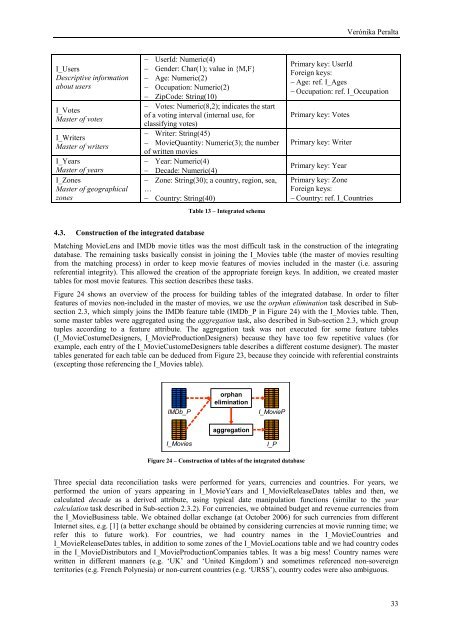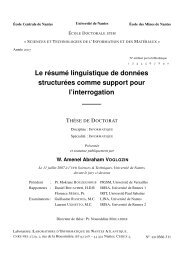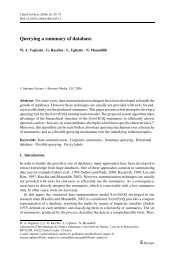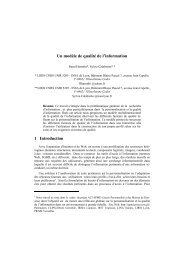Extraction and Integration of MovieLens and IMDb Data - APMD
Extraction and Integration of MovieLens and IMDb Data - APMD
Extraction and Integration of MovieLens and IMDb Data - APMD
Create successful ePaper yourself
Turn your PDF publications into a flip-book with our unique Google optimized e-Paper software.
I_Users<br />
Descriptive information<br />
about users<br />
I_Votes<br />
Master <strong>of</strong> votes<br />
I_Writers<br />
Master <strong>of</strong> writers<br />
I_Years<br />
Master <strong>of</strong> years<br />
I_Zones<br />
Master <strong>of</strong> geographical<br />
zones<br />
4.3. Construction <strong>of</strong> the integrated database<br />
− UserId: Numeric(4)<br />
− Gender: Char(1); value in {M,F}<br />
− Age: Numeric(2)<br />
− Occupation: Numeric(2)<br />
− ZipCode: String(10)<br />
− Votes: Numeric(8,2); indicates the start<br />
<strong>of</strong> a voting interval (internal use, for<br />
classifying votes)<br />
− Writer: String(45)<br />
− MovieQuantity: Numeric(3); the number<br />
<strong>of</strong> written movies<br />
− Year: Numeric(4)<br />
− Decade: Numeric(4)<br />
− Zone: String(30); a country, region, sea,<br />
…<br />
− Country: String(40)<br />
Table 13 – Integrated schema<br />
Verónika Peralta<br />
Primary key: UserId<br />
Foreign keys:<br />
− Age: ref. I_Ages<br />
− Occupation: ref. I_Occupation<br />
Primary key: Votes<br />
Primary key: Writer<br />
Primary key: Year<br />
Primary key: Zone<br />
Foreign keys:<br />
− Country: ref. I_Countries<br />
Matching <strong>MovieLens</strong> <strong>and</strong> <strong>IMDb</strong> movie titles was the most difficult task in the construction <strong>of</strong> the integrating<br />
database. The remaining tasks basically consist in joining the I_Movies table (the master <strong>of</strong> movies resulting<br />
from the matching process) in order to keep movie features <strong>of</strong> movies included in the master (i.e. assuring<br />
referential integrity). This allowed the creation <strong>of</strong> the appropriate foreign keys. In addition, we created master<br />
tables for most movie features. This section describes these tasks.<br />
Figure 24 shows an overview <strong>of</strong> the process for building tables <strong>of</strong> the integrated database. In order to filter<br />
features <strong>of</strong> movies non-included in the master <strong>of</strong> movies, we use the orphan elimination task described in Subsection<br />
2.3, which simply joins the <strong>IMDb</strong> feature table (<strong>IMDb</strong>_P in Figure 24) with the I_Movies table. Then,<br />
some master tables were aggregated using the aggregation task, also described in Sub-section 2.3, which group<br />
tuples according to a feature attribute. The aggregation task was not executed for some feature tables<br />
(I_MovieCostumeDesigners, I_MovieProductionDesigners) because they have too few repetitive values (for<br />
example, each entry <strong>of</strong> the I_MovieCustomeDesigners table describes a different costume designer). The master<br />
tables generated for each table can be deduced from Figure 23, because they coincide with referential constraints<br />
(excepting those referencing the I_Movies table).<br />
<strong>IMDb</strong>_P<br />
I_Movies<br />
orphan<br />
elimination<br />
aggregation<br />
I_MovieP<br />
I_P<br />
Figure 24 – Construction <strong>of</strong> tables <strong>of</strong> the integrated database<br />
Three special data reconciliation tasks were performed for years, currencies <strong>and</strong> countries. For years, we<br />
performed the union <strong>of</strong> years appearing in I_MovieYears <strong>and</strong> I_MovieReleaseDates tables <strong>and</strong> then, we<br />
calculated decade as a derived attribute, using typical date manipulation functions (similar to the year<br />
calculation task described in Sub-section 2.3.2). For currencies, we obtained budget <strong>and</strong> revenue currencies from<br />
the I_MovieBusiness table. We obtained dollar exchange (at October 2006) for such currencies from different<br />
Internet sites, e.g. [1] (a better exchange should be obtained by considering currencies at movie running time; we<br />
refer this to future work). For countries, we had country names in the I_MovieCountries <strong>and</strong><br />
I_MovieReleaseDates tables, in addition to some zones <strong>of</strong> the I_MovieLocations table <strong>and</strong> we had country codes<br />
in the I_MovieDistributors <strong>and</strong> I_MovieProductionCompanies tables. It was a big mess! Country names were<br />
written in different manners (e.g. ‘UK’ <strong>and</strong> ‘United Kingdom’) <strong>and</strong> sometimes referenced non-sovereign<br />
territories (e.g. French Polynesia) or non-current countries (e.g. ‘URSS’), country codes were also ambiguous.<br />
33







